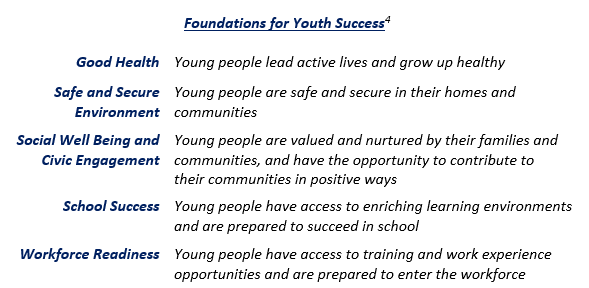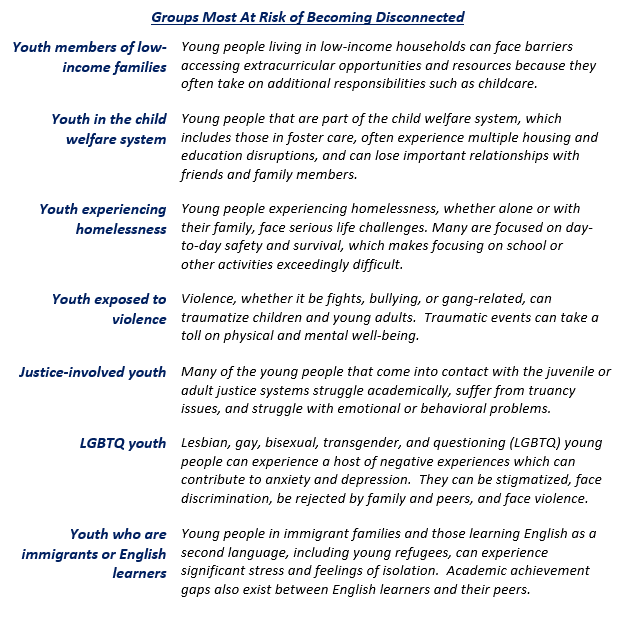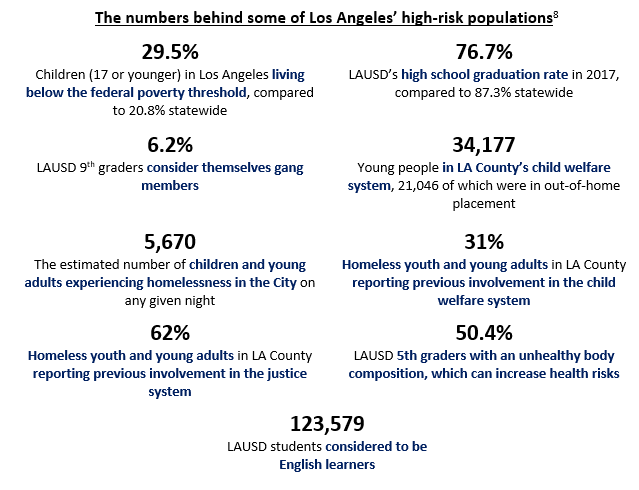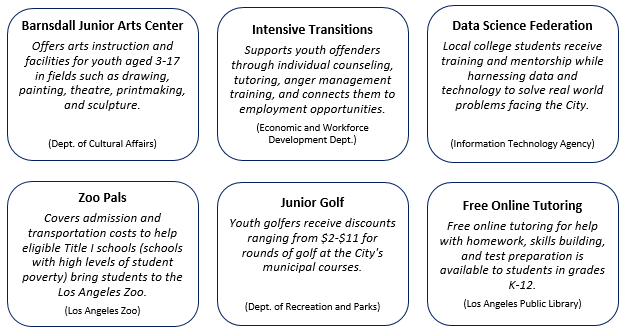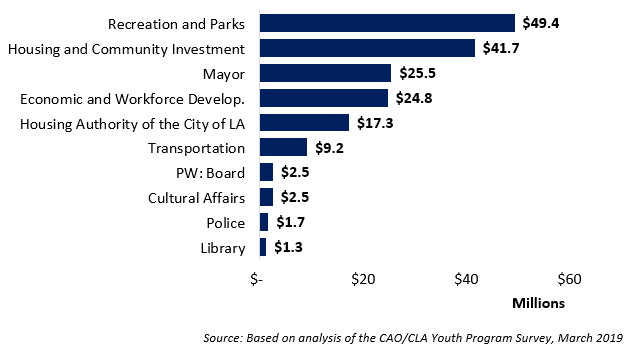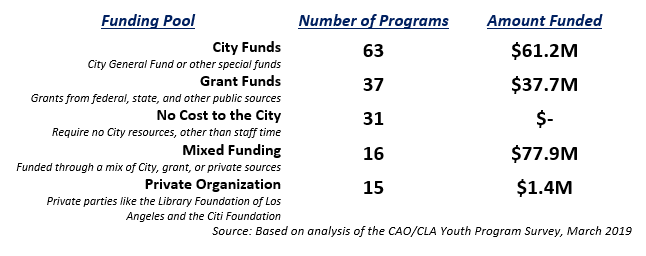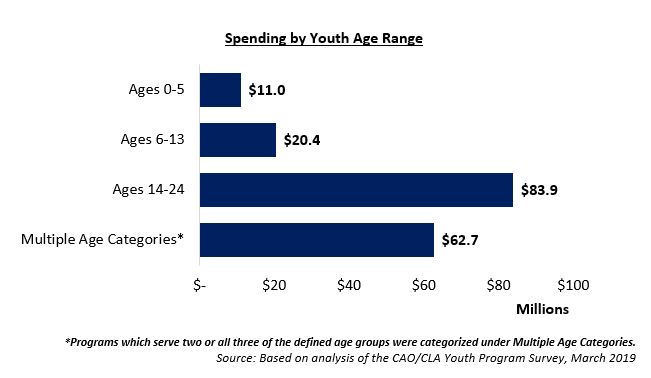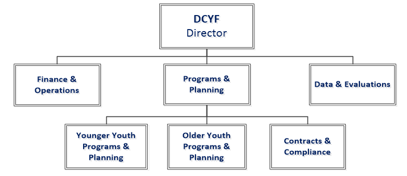Click Here to View Map of Youth Programs in L.A.
Executive Summary
Approximately 1.3 million Angelenos – or nearly one-third of the City’s population – are children, teens, and young adults who are 24 years old or younger. Our young people deserve access to resources that prepare them to lead healthy and fulfilling lives, and Los Angeles is home to world-class institutions offering many learning and development opportunities. Actively participating in safe and enriching programs can help improve self-confidence, increase academic achievement, and promote feelings of safety and belonging.
However, many young Angelenos face difficult circumstances that can make it challenging to take advantage of available learning and development opportunities. This report identifies and examines strategies which will help the City better invest in its youth.
Subject matter experts have identified several youth subpopulations – many of which overlap – that are most at risk of feeling isolated and falling behind:
- youth experiencing homelessness;
- members of low-income families;
- youth involved with child welfare or justice systems;
- youth exposed to violence;
- LGBTQ youth;
- immigrants; and
- English language learners.
Many of the City’s youth fall into these categories. For example, 29.5% of young people age 17 and under in Los Angeles live below the federal poverty threshold. The Los Angeles Homeless Services Authority estimates that 5,670 children and young adults are experiencing homelessness in the City, and more than 120,000 Los Angeles Unified School District students are English language learners.
Data also shows how challenges that some young people face can be interrelated. For example, 62% of homeless youth and young adults in Los Angeles County report previous involvement in the justice system, while 31% report previous involvement in the child welfare system. These statistics highlight how important it is for the City to provide all young people – regardless of their background and socioeconomic status – with targeted resources that can be used to improve youth outcomes.
Youth programs and services offered by the City generally focus on providing avenues beyond the classroom for young people to continue to learn, explore, be physically active, and develop life and career skills. The types of services offered range from arts and culture programming at the Department of Cultural Affairs, to early literacy programs at the Los Angeles Public Library, to cadet programs at the Los Angeles Police Department. The common thread is that the City’s youth programs are typically administered by individual departments.
The City recently published the results of a survey that was initiated to take stock of its existing youth programs. In all, 26 City departments reported that they offered 162 youth-related programs to Angelenos. Those departments reported that spending on City-administered and City-sponsored youth programs was an estimated $178 million in FY2018, including City funds and funding leveraged through grants and partnerships.
The City’s three proprietary departments (the Department of Water and Power, Port of Los Angeles, and Los Angeles World Airports) also offer youth services which provide access to learning opportunities in engineering, and the maritime and aviation industries. While this report does not focus on the youth activities administered by proprietary departments, their programs are an important component of the City’s youth services portfolio. The proprietary departments reported that they offered a total of 36 youth programs in FY2018.
It should be noted that these figures represent estimates for youth-specific programs across the City, as self-reported by departments. However, City spending on youth programs is likely higher because departments did not necessarily report administration costs such as staffing, costs associated with the construction and maintenance of facilities that support youth activities, or certain materials costs like children’s books at the library.
Regardless, the survey provides a snapshot of the City’s current portfolio of youth programs and can be broken down into the following categories, each with its own mission and role.
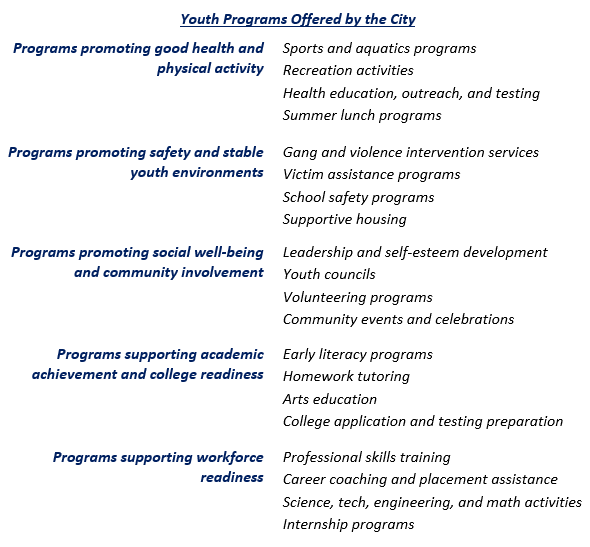
Although the City offers these programs, the lack of a citywide, youth-specific organizational framework creates several challenges that need to be resolved in order to ensure that high-quality services are available to all young Angelenos.
The City does not have a department or commission to serve as a strategy manager for youth programs. There is no single entity tasked with carrying out critical initiatives
- such as establishing citywide youth development goals, monitoring the City’s youth programming outcomes, evaluating programming to the ensure efficient service delivery, and improving service equity and inclusion. In the past, citywide coordination and advocacy was the responsibility of the Commission for Children, Youth, and Their Families. However, this commission was eliminated in 2010.
- The City does not have a comprehensive strategic or master plan to guide short- and long-term decisions about youth services planning, program development, and funding. Strategic plans can provide a comprehensive vision, outline needs and available resources, and create a structured plan for implementing successful youth programming.
- There is currently no single point of entry or information source for residents seeking youth programming information; residents must navigate multiple department websites or phone numbers. The overall effectiveness of any program is limited if potential participants are unaware of available opportunities. For example, Los Angeles Public Library staff said that many students and parents do not know that they can use their library card to access online tutoring services for homework and SAT/ACT preparation.
In March 2019, the City Council instructed the City Administrative Officer and Chief Legislative Analyst to report on options for developing an Executive Task Force on Youth Development, and is exploring funding options for establishing an office that would be responsible for implementing a citywide youth strategy.
Policymakers need to determine how the City’s youth framework should be structured. Although New York and San Francisco are different than Los Angeles because they are each a consolidated city-county, they provide important lessons. These jurisdictions each have an agency dedicated to youth services program management and rely on several initiatives such as comprehensive needs assessments, strategic investment plans, and annual reports to help make informed programming and funding decisions.
Regardless of how the City chooses to structure future youth initiatives, it will be vital that the youth strategy is data-driven, focused on achieving successful outcomes, and include a framework that enables continuous analysis and improvement. This report identifies steps the City should take as it evaluates the implementation its youth programs, and lays the foundation for a long term strategy for youth investment decisions. Those steps are listed below.
Step 1
Establish or designate a lead office or department to be responsible for youth initiatives, including citywide youth development strategy, program coordination, and advocacy.
Step 2
Analyze demographic, wellness, and achievement data to examine the specific needs of young Angelenos, and identify areas where programming is falling short of community needs and expectations.
Step 3
Develop a formal master plan which establishes goals for the City, establishes an implementation plan to achieve those goals, and guides departments as they make investment and operational decisions.
Step 4
Establish outcome-based performance indicators which measure the City’s progress towards achieving goals, and emphasize both program utilization and program impact.
Step 5
Explore partnership opportunities and collaborate with key stakeholders to improve programs and maximize the number of young Angelenos benefiting from youth services and opportunities.
Step 6
Develop a formal, consistent reporting platform in the form of progress reports or report cards, to allow policymakers, stakeholders, and the public to monitor the well-being of young Angelenos over time. These reports will allow the City to assess the impact of investments, and should be used to make necessary updates to youth master plans.
Conclusion
The City has an opportunity to transform how it provides services to its youth population. For nearly a decade, individual departments have provided programs without a comprehensive framework to establish goals, develop strategic plans, and measure performance. Prioritizing improvement in these areas would enable the City to:
- better understand emerging community needs and develop high-impact programs, especially for at-risk youth;
- determine whether existing programs are achieving intended outcomes; and
- ensure the City maximizes the value of funding dedicated to youth services.
The City should collaborate with partner agencies, community groups, and families to provide young people with the skills they need for success. With the right tools, all young Angelenos can accomplish great things.

